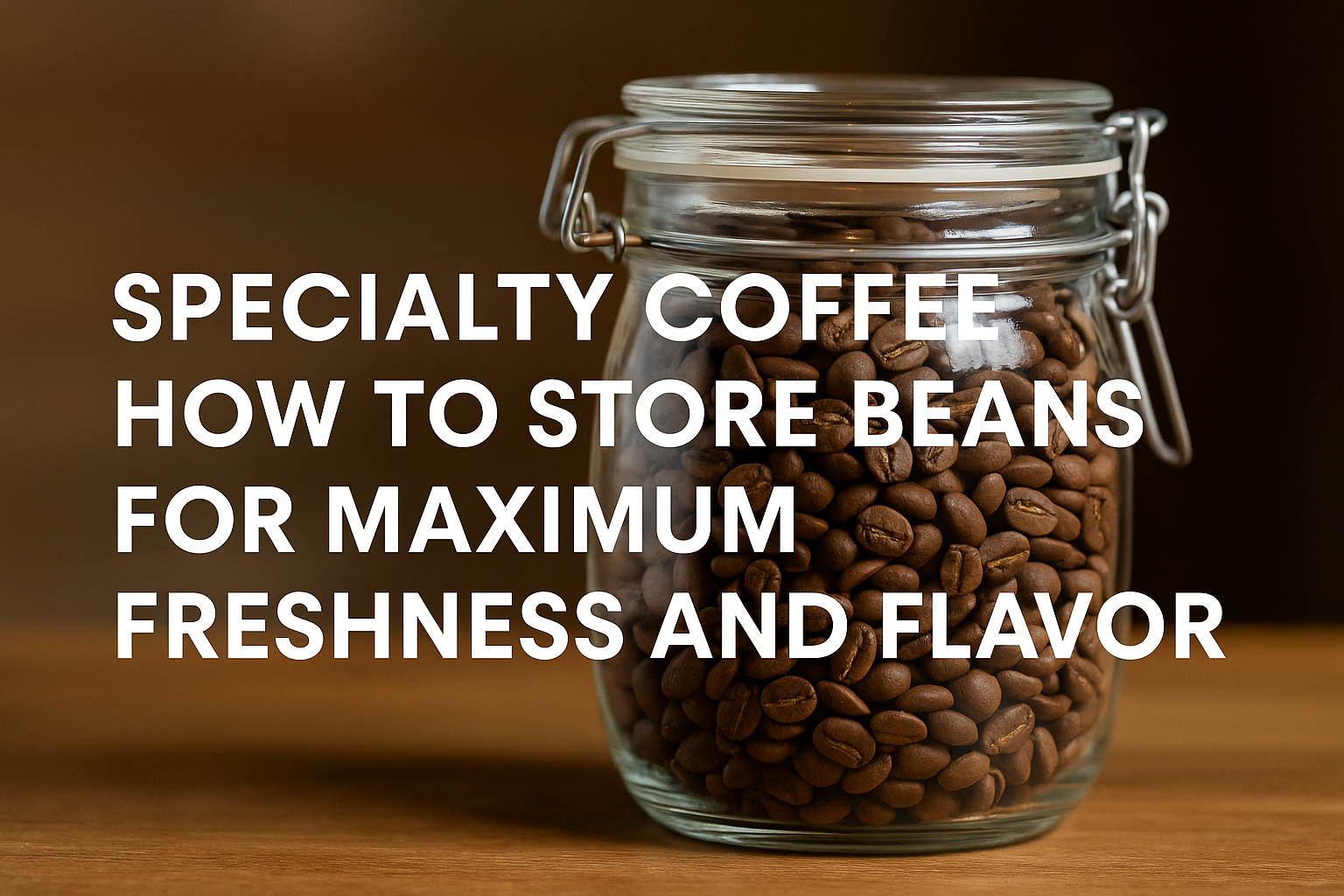One of the easiest ways to ruin even the best specialty coffee is to store it improperly.
As a barista or coffee enthusiast, you spend time choosing high-quality beans, dialing in your brew method, and perfecting your technique — but all of that can be wasted if your coffee goes stale before it ever hits the filter.
Proper storage isn’t complicated, but it is critical. It can make the difference between a vibrant, aromatic cup and one that tastes flat, dull, or bitter.
In this guide, you’ll learn how to store coffee beans the right way to protect freshness, flavor, and your investment in quality.
Why Coffee Goes Stale
Coffee is an agricultural product, and like any food item, it breaks down over time. The moment beans are roasted, they begin to lose their optimal flavor.
The four biggest enemies of coffee freshness are:
- Oxygen
- Moisture
- Heat
- Light
Each one contributes to oxidation, flavor degradation, or microbial growth — all of which lead to a stale, lifeless cup.
Knowing how to reduce these factors will help preserve the character of your specialty coffee.
Whole Beans vs Ground Coffee
The first rule of storing coffee properly is: always store whole beans, not ground coffee — at least until you’re ready to brew.
Grinding coffee dramatically increases its surface area, making it much more vulnerable to oxidation and aroma loss. Ground coffee starts going stale within minutes, while whole beans can stay fresh for weeks if stored correctly.
For this reason, baristas and professionals always grind beans fresh for each brew. If you don’t have a grinder at home, investing in one is one of the best upgrades you can make.
How Long Does Coffee Stay Fresh?
Freshness isn’t just about whether coffee is “safe” to drink — it’s about whether it still tastes as it should.
Generally speaking:
- Peak freshness for whole beans is between 4 and 21 days after roasting.
- Acceptable freshness can last up to 30–45 days.
- After 60 days, most coffees lose much of their brightness, aroma, and character.
This timeline varies depending on roast level (lighter roasts tend to age faster), packaging, storage conditions, and varietal. Some beans may hold up longer, but the general principle is: fresh is best.
Ideal Storage Conditions
Let’s break down what ideal coffee storage looks like:
1. Airtight Container
Oxygen is the biggest enemy of coffee freshness. Once beans are exposed to air, they begin to oxidize, resulting in stale flavors and muted aromas.
Use a container with an airtight seal. Vacuum-sealed containers or ones with one-way valves are even better, as they allow gases to escape without letting oxygen in.
Avoid storing coffee in the bag it came in unless it’s resealable and designed for long-term storage (like most specialty coffee bags with a one-way valve).
2. Cool, Stable Temperature
Heat accelerates chemical breakdown, so avoid storing coffee near ovens, stoves, windows, or any heat sources. Keep your coffee in a cool, dark place with a stable temperature.
Aim for a storage temperature between 15–25°C (59–77°F). Avoid refrigerators (more on that soon).
3. No Light Exposure
UV light causes coffee to degrade by breaking down delicate aromatic compounds. This is why most specialty coffee bags are opaque or foil-lined.
If you’re storing coffee in a glass container, make sure it’s in a cupboard or wrapped to block light.
4. Dry Environment
Moisture causes coffee to absorb unwanted smells, develop mold, or age unevenly. Never store coffee in a humid place — and always keep the container tightly sealed after each use.
This is another reason to avoid the refrigerator. The frequent opening and closing causes condensation, and coffee can absorb smells from other foods.
Should You Freeze Coffee Beans?
Freezing coffee beans is controversial. Some professionals do it with great care, others avoid it completely.
Freezing can preserve freshness if done correctly:
- Only freeze unopened bags or portioned doses in airtight, vacuum-sealed containers.
- Do not open the bag until it’s completely thawed to avoid condensation.
- Never refreeze beans once thawed.
Freezing is useful for long-term storage or if you bought coffee in bulk and want to save part of it for later. For day-to-day use, it’s better to store your main supply at room temperature.
Best Containers for Storing Coffee
Here are a few top options baristas and coffee lovers trust:
- Airscape Containers: These have a special valve that pushes air out and creates a partial vacuum.
- Fellow Atmos Vacuum Canister: A sleek container that removes oxygen with a built-in pump.
- Mason Jars (if airtight): Affordable but must be stored in a dark place.
- Specialty Resealable Bags with One-Way Valve: If they’re high quality, these can preserve freshness well for a few weeks.
Avoid:
- Clear containers exposed to light
- Ziplock bags
- Unsealed bulk bins
Tips for Cafés and Baristas
In a commercial setting, proper storage becomes even more important because you’re working with larger volumes of coffee and aiming for consistency.
Here are some essential practices for cafés:
- Use FIFO (First In, First Out): Rotate coffee stock so that older beans are used first.
- Weigh and store in small daily portions: Keep the main bag sealed and refill hoppers as needed.
- Clean grinders daily: Old grounds can oxidize and contaminate fresh doses.
- Track roast dates carefully: Don’t rely on smell alone to judge freshness.
Customers may not notice if a coffee is five days or ten days past its peak, but over time, your overall coffee quality will reflect these small details.
Signs Your Coffee Has Gone Stale
Not sure if your beans are still fresh? Here are some signs of staleness:
- Muted aroma: Fresh coffee smells vibrant, floral, fruity, or nutty. Stale coffee has little to no aroma.
- Flat flavor: A lack of complexity, sweetness, or acidity.
- Bitter or cardboard taste: Oxidation often introduces off-notes that taste papery or woody.
- Lack of crema (for espresso): Crema disappears as CO₂ levels drop, which happens naturally as beans age.
If your cup tastes off, and you’ve ruled out grind, water, and technique, the culprit might be storage or old beans.
How Much Coffee Should You Buy at a Time?
One way to preserve freshness is to only buy what you can use in 2 to 3 weeks. Specialty coffee isn’t designed to sit on a shelf indefinitely.
Many roasters offer 250g or 500g bags, perfect for home use. If you’re running a café, order in bulk — but plan carefully based on turnover.
If you’re experimenting with new coffees, order smaller batches so you can enjoy them at their peak.
How to Talk About Coffee Storage With Customers
As a barista, customers may ask how to store the coffee they buy from your café or roastery. This is your opportunity to provide helpful, simple advice:
You might say:
“Keep the beans in an airtight container, in a cool, dark place. No fridge or freezer needed unless you’re storing it long-term.”
Or:
“Try to use the coffee within three weeks of roasting. After that, the flavors start to fade.”
Helping customers enjoy great coffee at home builds loyalty and trust — and keeps them coming back for more.
Final Thoughts: Respect the Bean
Storing specialty coffee correctly isn’t about perfection — it’s about respect. You’re honoring the work of farmers, roasters, and everyone involved in the journey from seed to cup.
By protecting the freshness of your beans, you ensure that every cup delivers the flavors that were so carefully cultivated and crafted.
Whether you’re at home or behind the bar, good storage is part of good coffee. Make it a habit, and your brews will always taste better — fresher, richer, and more alive.

Marcelo Rodrigues is a passionate barista with over 7 years of experience in specialty coffee. He’s worked in top cafés, led barista training sessions, and now shares practical tips to help beginners and coffee lovers improve their skills. Through this blog, Marcel makes the world of coffee more accessible—one cup at a time.

